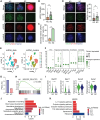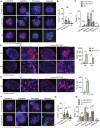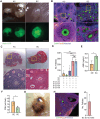Follicular development of fetal gonads under the skin of adult mice
- PMID: 40386496
- PMCID: PMC12084806
- DOI: 10.1093/lifemedi/lnaf007
Follicular development of fetal gonads under the skin of adult mice
Abstract
Adult ovarian tissues or biopsies isolated from patients prior to chemotherapy or irradiation can reconstitute ovarian functions when transplanted either in the abdomen or subcutaneously. Subcutaneously transplantation avoids invasive surgery and potential risks associated with internal procedures. We investigated whether functional ovaries could develop subcutaneously from early E12.5 fetal gonads without entering meiosis in mouse model. Unexpectedly, the subcutaneously transplanted fetal gonads failed to undergo folliculogenesis in the recipient mice. The transplanted gonads experienced meiotic deficiency and exhibited significant defects in DNA repair and recombination, increased apoptosis levels. Meiotic defects in the subcutaneous grafts were partly attributable to variations in temperature and oxygen concentration. However, completion of meiotic prophase I was effectively achieved through in vitro culture of the gonads at 37°C. Subsequently, the in vitro cultured E12.5 gonads, following subcutaneous transplantation, became competent in folliculogenesis, restoring endocrine functions. This finding may have implications for rejuvenating ovarioids from fetal gonad-like cells using pluripotent stem cell technologies, as well as for enhancing endocrine recovery and health span.
Keywords: follicle development; gonad; meiosis; ovary; subcutaneous transplantation.
© The Author(s) 2025. Published by Oxford University Press on behalf of Higher Education Press.
Conflict of interest statement
The authors declare no competing interests.
Figures






Similar articles
-
Effects of in vitro culture of mouse fetal gonads on subsequent ovarian development in vivo and oocyte maturation in vitro.Hum Cell. 2009 May;22(2):43-8. doi: 10.1111/j.1749-0774.2009.00067.x. Hum Cell. 2009. PMID: 19379463
-
Ex vivo culture of human fetal gonads: manipulation of meiosis signalling by retinoic acid treatment disrupts testis development.Hum Reprod. 2015 Oct;30(10):2351-63. doi: 10.1093/humrep/dev194. Epub 2015 Aug 6. Hum Reprod. 2015. PMID: 26251460 Free PMC article.
-
Follicular development in transplanted fetal and neonatal mouse ovaries is influenced by the gonadal status of the adult recipient.Fertil Steril. 2000 Aug;74(2):366-71. doi: 10.1016/s0015-0282(00)00635-x. Fertil Steril. 2000. PMID: 10927060
-
Overactive type 2 cannabinoid receptor induces meiosis in fetal gonads and impairs ovarian reserve.Cell Death Dis. 2017 Oct 5;8(10):e3085. doi: 10.1038/cddis.2017.496. Cell Death Dis. 2017. PMID: 28981118 Free PMC article.
-
SRSF1 regulates primordial follicle formation and number determination during meiotic prophase I.BMC Biol. 2023 Mar 8;21(1):49. doi: 10.1186/s12915-023-01549-7. BMC Biol. 2023. PMID: 36882745 Free PMC article.
References
-
- Lobo RA. Hormone-replacement therapy: current thinking. Nat Rev Endocrinol 2017;13:220–31. - PubMed
LinkOut - more resources
Full Text Sources
